Accounting Standard for Lease: A Critical Review of AASB 16 - HI6025
VerifiedAdded on 2023/03/20
|17
|4764
|66
Report
AI Summary
This report critically examines the Australian accounting standard for lease financing, AASB 16. It begins with an abstract summarizing the key points. The introduction provides context on the importance of lease accounting and the shift from AASB 117 to AASB 16. The report then delves into a critical evaluation of the old AASB 117, highlighting its drawbacks, such as the misrepresentation of liabilities and the difficulty in comparing companies. It explains the reasons behind the change to AASB 16, including the need for greater transparency and comparability. The changes incorporated in AASB 16, such as the single lessee accounting approach and the recognition of right-of-use assets and lease liabilities, are detailed. The report analyzes how companies with significant lease financing are affected by the new standard, the reasons organizations classified leases as operating leases under the old standard, and the relevance of Positive Accounting Theory. It also explains the AISB's view and how AASB 16 might impact asset purchasing versus leasing decisions. The report concludes with key disclosures made by BHP Group Limited on accounting for leases and the effect of the transition to AASB 16, providing a practical application of the concepts discussed.
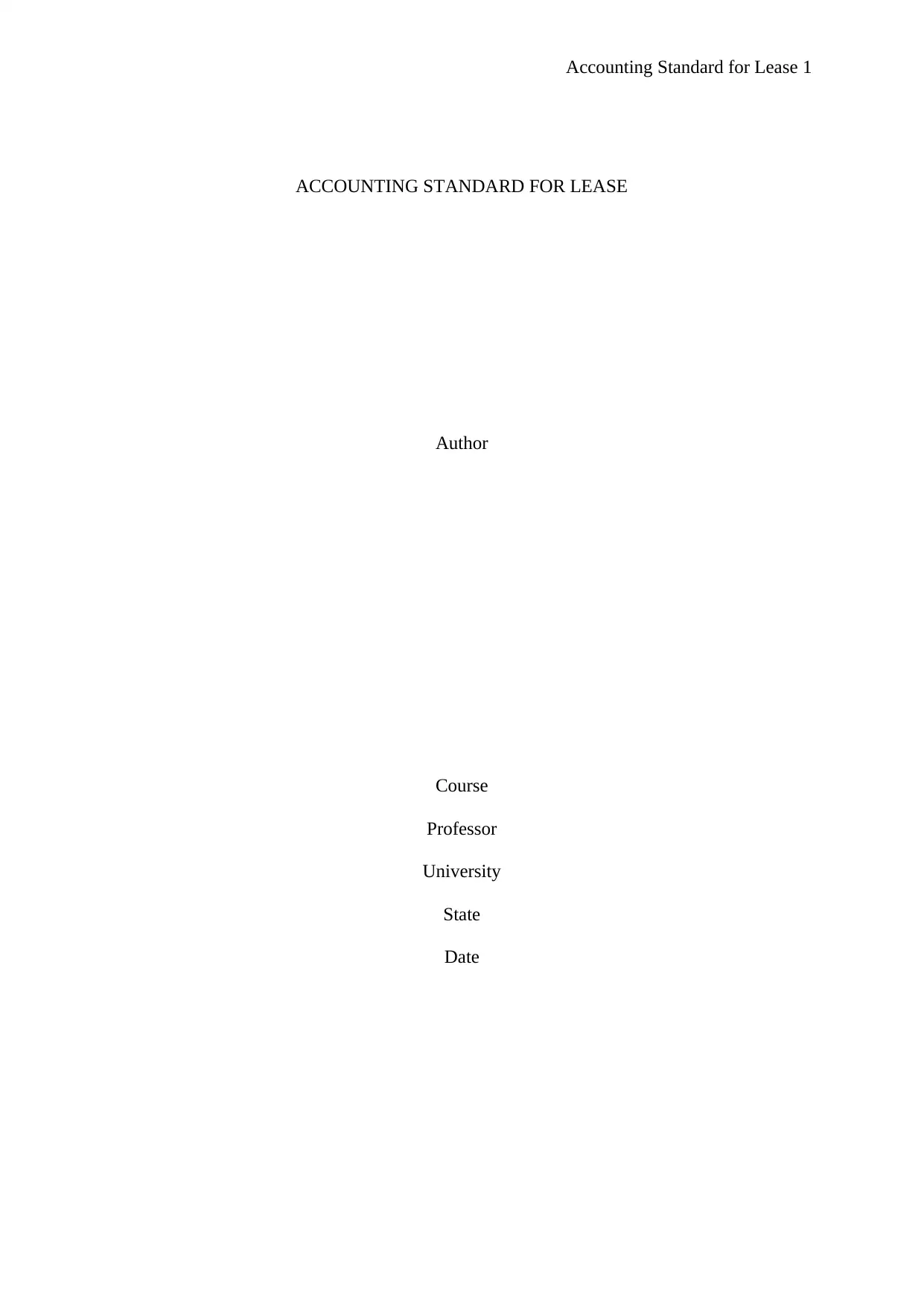
Accounting Standard for Lease 1
ACCOUNTING STANDARD FOR LEASE
Author
Course
Professor
University
State
Date
ACCOUNTING STANDARD FOR LEASE
Author
Course
Professor
University
State
Date
Paraphrase This Document
Need a fresh take? Get an instant paraphrase of this document with our AI Paraphraser
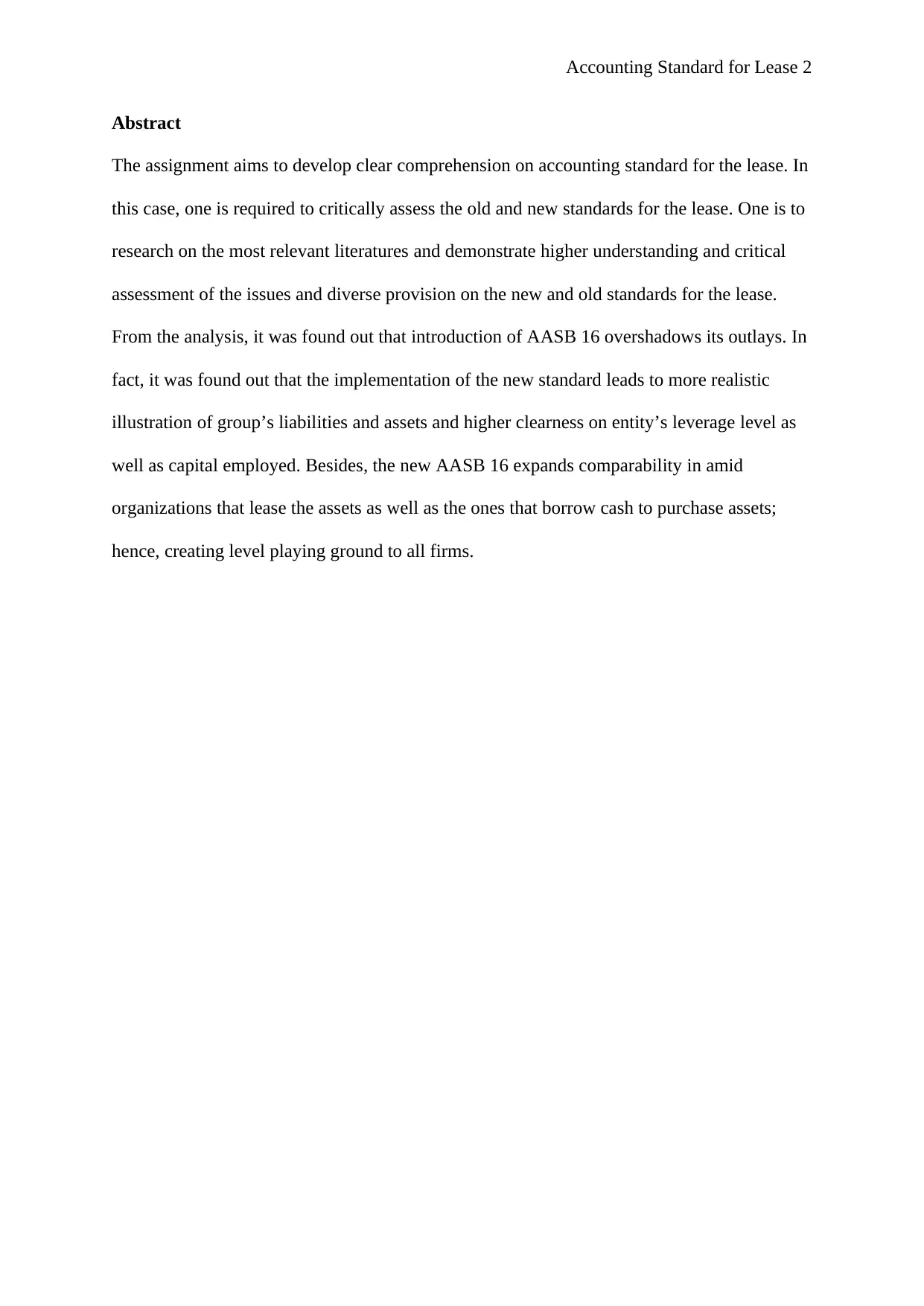
Accounting Standard for Lease 2
Abstract
The assignment aims to develop clear comprehension on accounting standard for the lease. In
this case, one is required to critically assess the old and new standards for the lease. One is to
research on the most relevant literatures and demonstrate higher understanding and critical
assessment of the issues and diverse provision on the new and old standards for the lease.
From the analysis, it was found out that introduction of AASB 16 overshadows its outlays. In
fact, it was found out that the implementation of the new standard leads to more realistic
illustration of group’s liabilities and assets and higher clearness on entity’s leverage level as
well as capital employed. Besides, the new AASB 16 expands comparability in amid
organizations that lease the assets as well as the ones that borrow cash to purchase assets;
hence, creating level playing ground to all firms.
Abstract
The assignment aims to develop clear comprehension on accounting standard for the lease. In
this case, one is required to critically assess the old and new standards for the lease. One is to
research on the most relevant literatures and demonstrate higher understanding and critical
assessment of the issues and diverse provision on the new and old standards for the lease.
From the analysis, it was found out that introduction of AASB 16 overshadows its outlays. In
fact, it was found out that the implementation of the new standard leads to more realistic
illustration of group’s liabilities and assets and higher clearness on entity’s leverage level as
well as capital employed. Besides, the new AASB 16 expands comparability in amid
organizations that lease the assets as well as the ones that borrow cash to purchase assets;
hence, creating level playing ground to all firms.
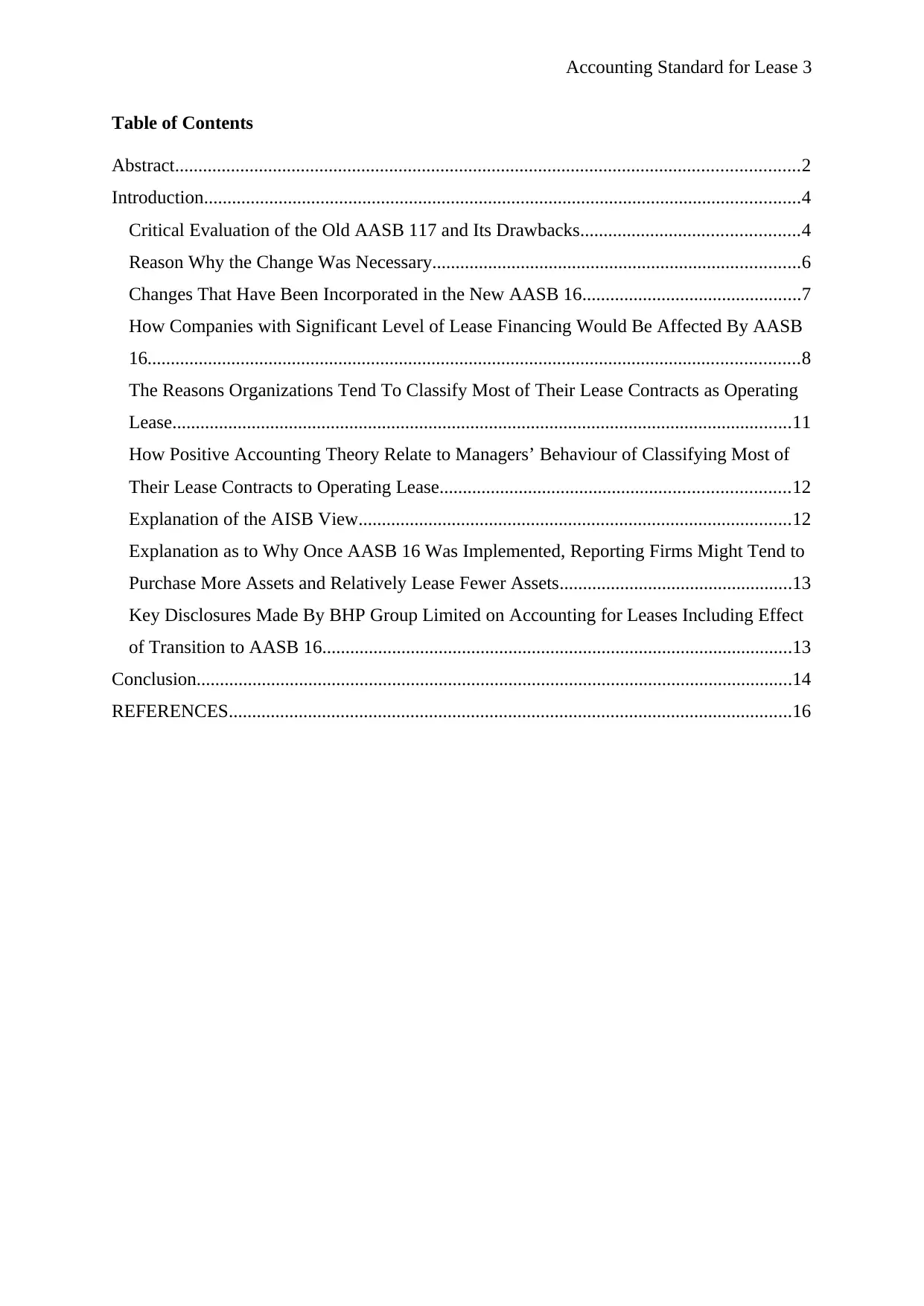
Accounting Standard for Lease 3
Table of Contents
Abstract......................................................................................................................................2
Introduction................................................................................................................................4
Critical Evaluation of the Old AASB 117 and Its Drawbacks...............................................4
Reason Why the Change Was Necessary...............................................................................6
Changes That Have Been Incorporated in the New AASB 16...............................................7
How Companies with Significant Level of Lease Financing Would Be Affected By AASB
16............................................................................................................................................8
The Reasons Organizations Tend To Classify Most of Their Lease Contracts as Operating
Lease.....................................................................................................................................11
How Positive Accounting Theory Relate to Managers’ Behaviour of Classifying Most of
Their Lease Contracts to Operating Lease...........................................................................12
Explanation of the AISB View.............................................................................................12
Explanation as to Why Once AASB 16 Was Implemented, Reporting Firms Might Tend to
Purchase More Assets and Relatively Lease Fewer Assets..................................................13
Key Disclosures Made By BHP Group Limited on Accounting for Leases Including Effect
of Transition to AASB 16.....................................................................................................13
Conclusion................................................................................................................................14
REFERENCES.........................................................................................................................16
Table of Contents
Abstract......................................................................................................................................2
Introduction................................................................................................................................4
Critical Evaluation of the Old AASB 117 and Its Drawbacks...............................................4
Reason Why the Change Was Necessary...............................................................................6
Changes That Have Been Incorporated in the New AASB 16...............................................7
How Companies with Significant Level of Lease Financing Would Be Affected By AASB
16............................................................................................................................................8
The Reasons Organizations Tend To Classify Most of Their Lease Contracts as Operating
Lease.....................................................................................................................................11
How Positive Accounting Theory Relate to Managers’ Behaviour of Classifying Most of
Their Lease Contracts to Operating Lease...........................................................................12
Explanation of the AISB View.............................................................................................12
Explanation as to Why Once AASB 16 Was Implemented, Reporting Firms Might Tend to
Purchase More Assets and Relatively Lease Fewer Assets..................................................13
Key Disclosures Made By BHP Group Limited on Accounting for Leases Including Effect
of Transition to AASB 16.....................................................................................................13
Conclusion................................................................................................................................14
REFERENCES.........................................................................................................................16
⊘ This is a preview!⊘
Do you want full access?
Subscribe today to unlock all pages.

Trusted by 1+ million students worldwide
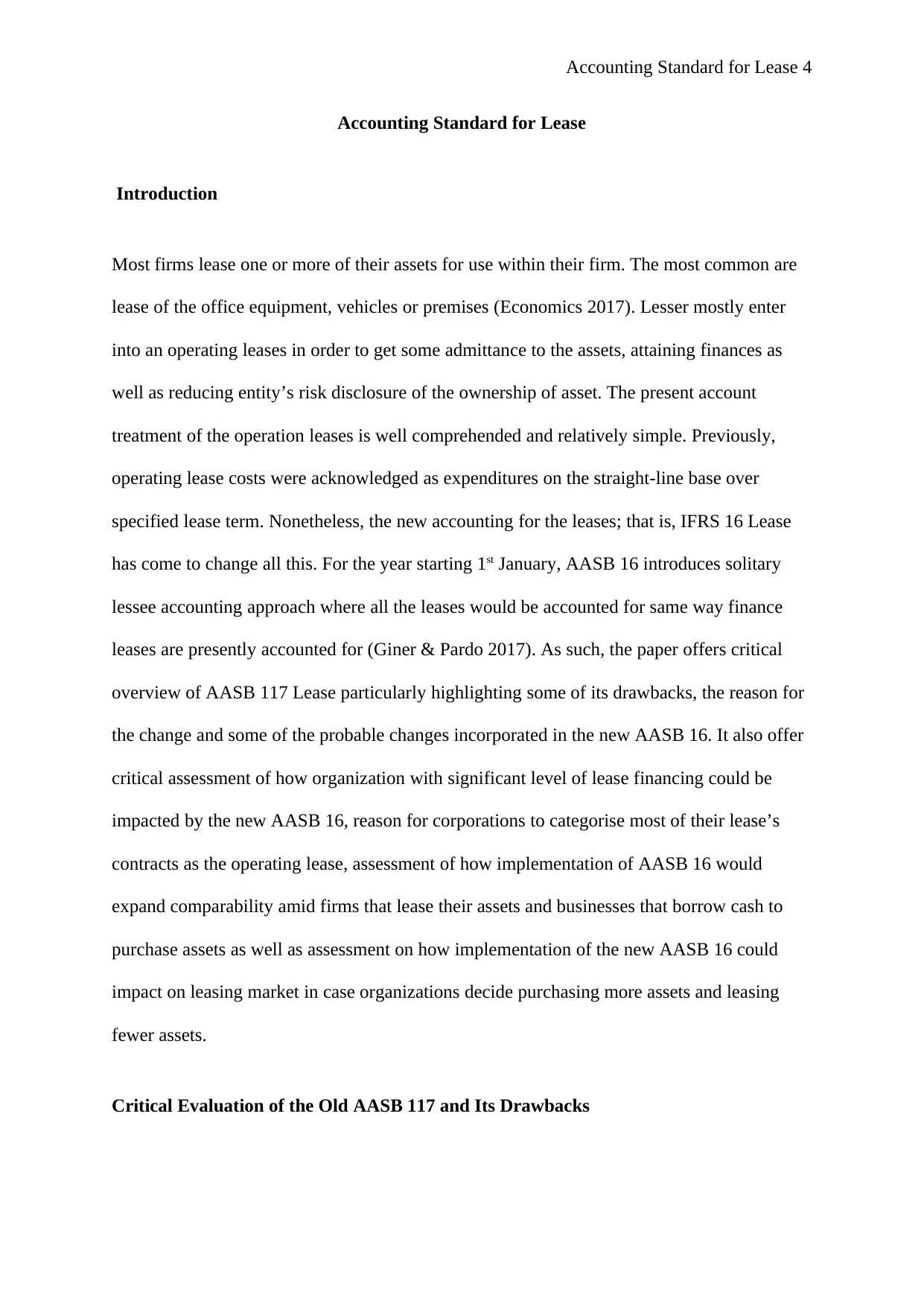
Accounting Standard for Lease 4
Accounting Standard for Lease
Introduction
Most firms lease one or more of their assets for use within their firm. The most common are
lease of the office equipment, vehicles or premises (Economics 2017). Lesser mostly enter
into an operating leases in order to get some admittance to the assets, attaining finances as
well as reducing entity’s risk disclosure of the ownership of asset. The present account
treatment of the operation leases is well comprehended and relatively simple. Previously,
operating lease costs were acknowledged as expenditures on the straight-line base over
specified lease term. Nonetheless, the new accounting for the leases; that is, IFRS 16 Lease
has come to change all this. For the year starting 1st January, AASB 16 introduces solitary
lessee accounting approach where all the leases would be accounted for same way finance
leases are presently accounted for (Giner & Pardo 2017). As such, the paper offers critical
overview of AASB 117 Lease particularly highlighting some of its drawbacks, the reason for
the change and some of the probable changes incorporated in the new AASB 16. It also offer
critical assessment of how organization with significant level of lease financing could be
impacted by the new AASB 16, reason for corporations to categorise most of their lease’s
contracts as the operating lease, assessment of how implementation of AASB 16 would
expand comparability amid firms that lease their assets and businesses that borrow cash to
purchase assets as well as assessment on how implementation of the new AASB 16 could
impact on leasing market in case organizations decide purchasing more assets and leasing
fewer assets.
Critical Evaluation of the Old AASB 117 and Its Drawbacks
Accounting Standard for Lease
Introduction
Most firms lease one or more of their assets for use within their firm. The most common are
lease of the office equipment, vehicles or premises (Economics 2017). Lesser mostly enter
into an operating leases in order to get some admittance to the assets, attaining finances as
well as reducing entity’s risk disclosure of the ownership of asset. The present account
treatment of the operation leases is well comprehended and relatively simple. Previously,
operating lease costs were acknowledged as expenditures on the straight-line base over
specified lease term. Nonetheless, the new accounting for the leases; that is, IFRS 16 Lease
has come to change all this. For the year starting 1st January, AASB 16 introduces solitary
lessee accounting approach where all the leases would be accounted for same way finance
leases are presently accounted for (Giner & Pardo 2017). As such, the paper offers critical
overview of AASB 117 Lease particularly highlighting some of its drawbacks, the reason for
the change and some of the probable changes incorporated in the new AASB 16. It also offer
critical assessment of how organization with significant level of lease financing could be
impacted by the new AASB 16, reason for corporations to categorise most of their lease’s
contracts as the operating lease, assessment of how implementation of AASB 16 would
expand comparability amid firms that lease their assets and businesses that borrow cash to
purchase assets as well as assessment on how implementation of the new AASB 16 could
impact on leasing market in case organizations decide purchasing more assets and leasing
fewer assets.
Critical Evaluation of the Old AASB 117 and Its Drawbacks
Paraphrase This Document
Need a fresh take? Get an instant paraphrase of this document with our AI Paraphraser
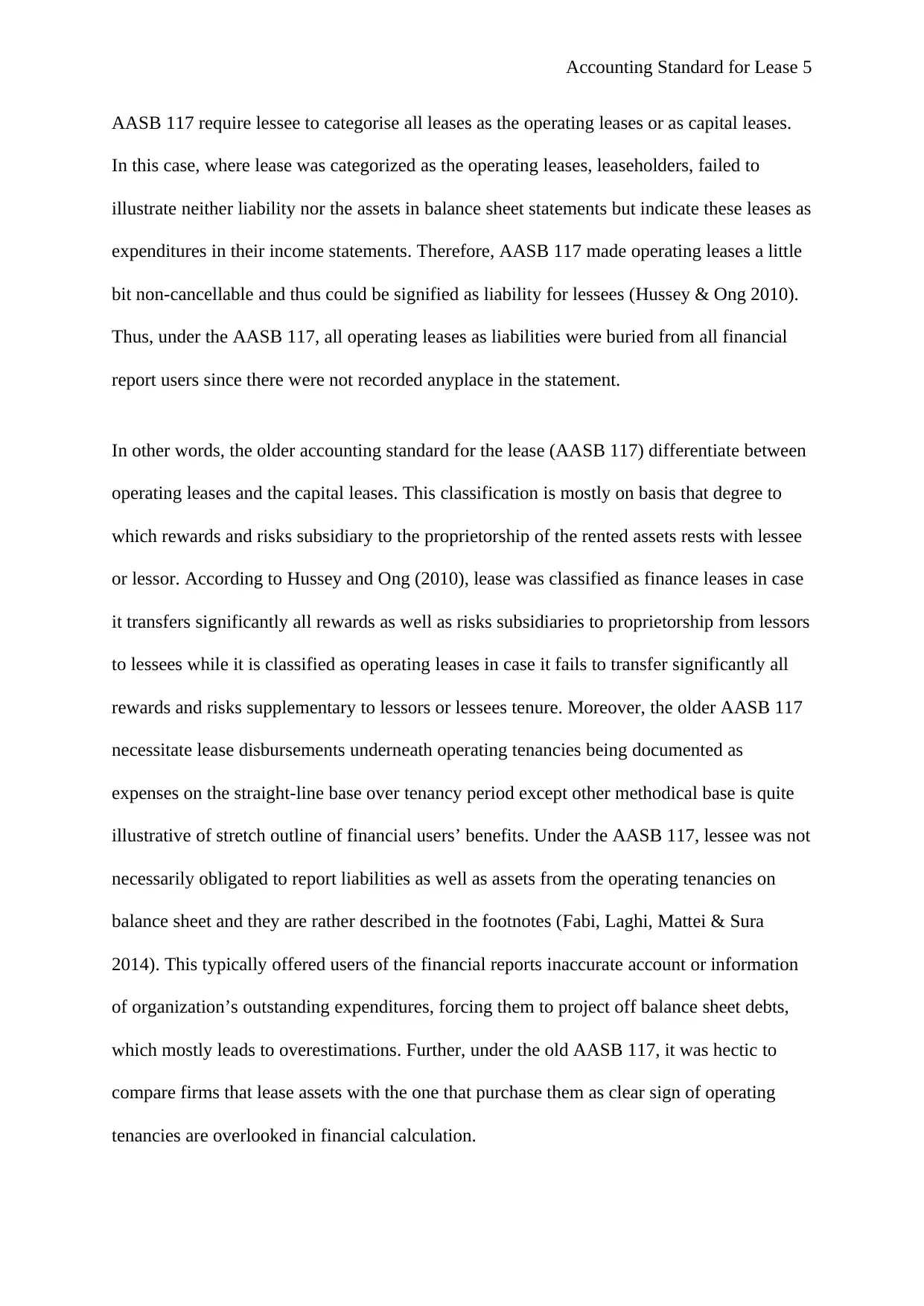
Accounting Standard for Lease 5
AASB 117 require lessee to categorise all leases as the operating leases or as capital leases.
In this case, where lease was categorized as the operating leases, leaseholders, failed to
illustrate neither liability nor the assets in balance sheet statements but indicate these leases as
expenditures in their income statements. Therefore, AASB 117 made operating leases a little
bit non-cancellable and thus could be signified as liability for lessees (Hussey & Ong 2010).
Thus, under the AASB 117, all operating leases as liabilities were buried from all financial
report users since there were not recorded anyplace in the statement.
In other words, the older accounting standard for the lease (AASB 117) differentiate between
operating leases and the capital leases. This classification is mostly on basis that degree to
which rewards and risks subsidiary to the proprietorship of the rented assets rests with lessee
or lessor. According to Hussey and Ong (2010), lease was classified as finance leases in case
it transfers significantly all rewards as well as risks subsidiaries to proprietorship from lessors
to lessees while it is classified as operating leases in case it fails to transfer significantly all
rewards and risks supplementary to lessors or lessees tenure. Moreover, the older AASB 117
necessitate lease disbursements underneath operating tenancies being documented as
expenses on the straight-line base over tenancy period except other methodical base is quite
illustrative of stretch outline of financial users’ benefits. Under the AASB 117, lessee was not
necessarily obligated to report liabilities as well as assets from the operating tenancies on
balance sheet and they are rather described in the footnotes (Fabi, Laghi, Mattei & Sura
2014). This typically offered users of the financial reports inaccurate account or information
of organization’s outstanding expenditures, forcing them to project off balance sheet debts,
which mostly leads to overestimations. Further, under the old AASB 117, it was hectic to
compare firms that lease assets with the one that purchase them as clear sign of operating
tenancies are overlooked in financial calculation.
AASB 117 require lessee to categorise all leases as the operating leases or as capital leases.
In this case, where lease was categorized as the operating leases, leaseholders, failed to
illustrate neither liability nor the assets in balance sheet statements but indicate these leases as
expenditures in their income statements. Therefore, AASB 117 made operating leases a little
bit non-cancellable and thus could be signified as liability for lessees (Hussey & Ong 2010).
Thus, under the AASB 117, all operating leases as liabilities were buried from all financial
report users since there were not recorded anyplace in the statement.
In other words, the older accounting standard for the lease (AASB 117) differentiate between
operating leases and the capital leases. This classification is mostly on basis that degree to
which rewards and risks subsidiary to the proprietorship of the rented assets rests with lessee
or lessor. According to Hussey and Ong (2010), lease was classified as finance leases in case
it transfers significantly all rewards as well as risks subsidiaries to proprietorship from lessors
to lessees while it is classified as operating leases in case it fails to transfer significantly all
rewards and risks supplementary to lessors or lessees tenure. Moreover, the older AASB 117
necessitate lease disbursements underneath operating tenancies being documented as
expenses on the straight-line base over tenancy period except other methodical base is quite
illustrative of stretch outline of financial users’ benefits. Under the AASB 117, lessee was not
necessarily obligated to report liabilities as well as assets from the operating tenancies on
balance sheet and they are rather described in the footnotes (Fabi, Laghi, Mattei & Sura
2014). This typically offered users of the financial reports inaccurate account or information
of organization’s outstanding expenditures, forcing them to project off balance sheet debts,
which mostly leads to overestimations. Further, under the old AASB 117, it was hectic to
compare firms that lease assets with the one that purchase them as clear sign of operating
tenancies are overlooked in financial calculation.
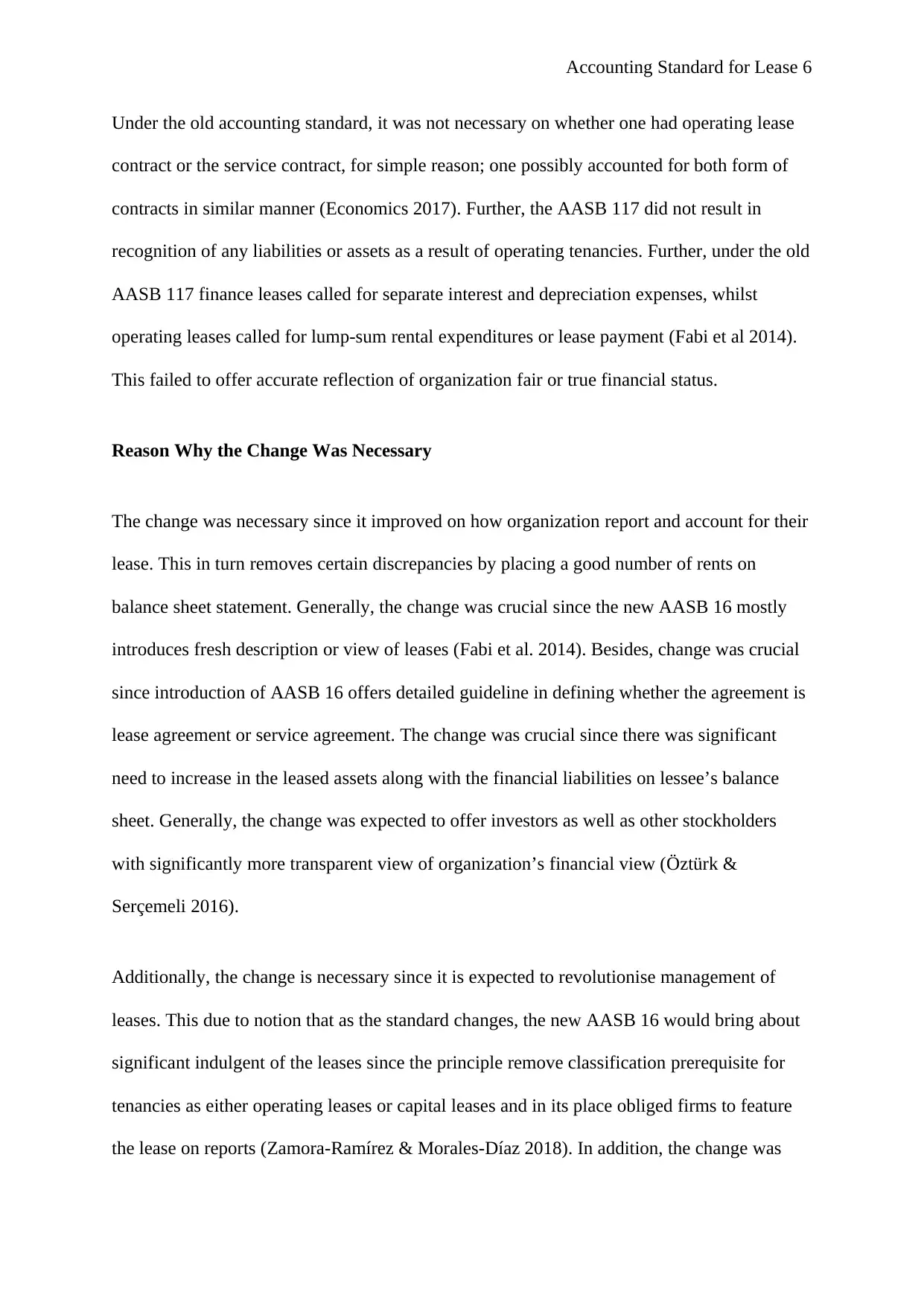
Accounting Standard for Lease 6
Under the old accounting standard, it was not necessary on whether one had operating lease
contract or the service contract, for simple reason; one possibly accounted for both form of
contracts in similar manner (Economics 2017). Further, the AASB 117 did not result in
recognition of any liabilities or assets as a result of operating tenancies. Further, under the old
AASB 117 finance leases called for separate interest and depreciation expenses, whilst
operating leases called for lump-sum rental expenditures or lease payment (Fabi et al 2014).
This failed to offer accurate reflection of organization fair or true financial status.
Reason Why the Change Was Necessary
The change was necessary since it improved on how organization report and account for their
lease. This in turn removes certain discrepancies by placing a good number of rents on
balance sheet statement. Generally, the change was crucial since the new AASB 16 mostly
introduces fresh description or view of leases (Fabi et al. 2014). Besides, change was crucial
since introduction of AASB 16 offers detailed guideline in defining whether the agreement is
lease agreement or service agreement. The change was crucial since there was significant
need to increase in the leased assets along with the financial liabilities on lessee’s balance
sheet. Generally, the change was expected to offer investors as well as other stockholders
with significantly more transparent view of organization’s financial view (Öztürk &
Serçemeli 2016).
Additionally, the change is necessary since it is expected to revolutionise management of
leases. This due to notion that as the standard changes, the new AASB 16 would bring about
significant indulgent of the leases since the principle remove classification prerequisite for
tenancies as either operating leases or capital leases and in its place obliged firms to feature
the lease on reports (Zamora-Ramírez & Morales-Díaz 2018). In addition, the change was
Under the old accounting standard, it was not necessary on whether one had operating lease
contract or the service contract, for simple reason; one possibly accounted for both form of
contracts in similar manner (Economics 2017). Further, the AASB 117 did not result in
recognition of any liabilities or assets as a result of operating tenancies. Further, under the old
AASB 117 finance leases called for separate interest and depreciation expenses, whilst
operating leases called for lump-sum rental expenditures or lease payment (Fabi et al 2014).
This failed to offer accurate reflection of organization fair or true financial status.
Reason Why the Change Was Necessary
The change was necessary since it improved on how organization report and account for their
lease. This in turn removes certain discrepancies by placing a good number of rents on
balance sheet statement. Generally, the change was crucial since the new AASB 16 mostly
introduces fresh description or view of leases (Fabi et al. 2014). Besides, change was crucial
since introduction of AASB 16 offers detailed guideline in defining whether the agreement is
lease agreement or service agreement. The change was crucial since there was significant
need to increase in the leased assets along with the financial liabilities on lessee’s balance
sheet. Generally, the change was expected to offer investors as well as other stockholders
with significantly more transparent view of organization’s financial view (Öztürk &
Serçemeli 2016).
Additionally, the change is necessary since it is expected to revolutionise management of
leases. This due to notion that as the standard changes, the new AASB 16 would bring about
significant indulgent of the leases since the principle remove classification prerequisite for
tenancies as either operating leases or capital leases and in its place obliged firms to feature
the lease on reports (Zamora-Ramírez & Morales-Díaz 2018). In addition, the change was
⊘ This is a preview!⊘
Do you want full access?
Subscribe today to unlock all pages.

Trusted by 1+ million students worldwide
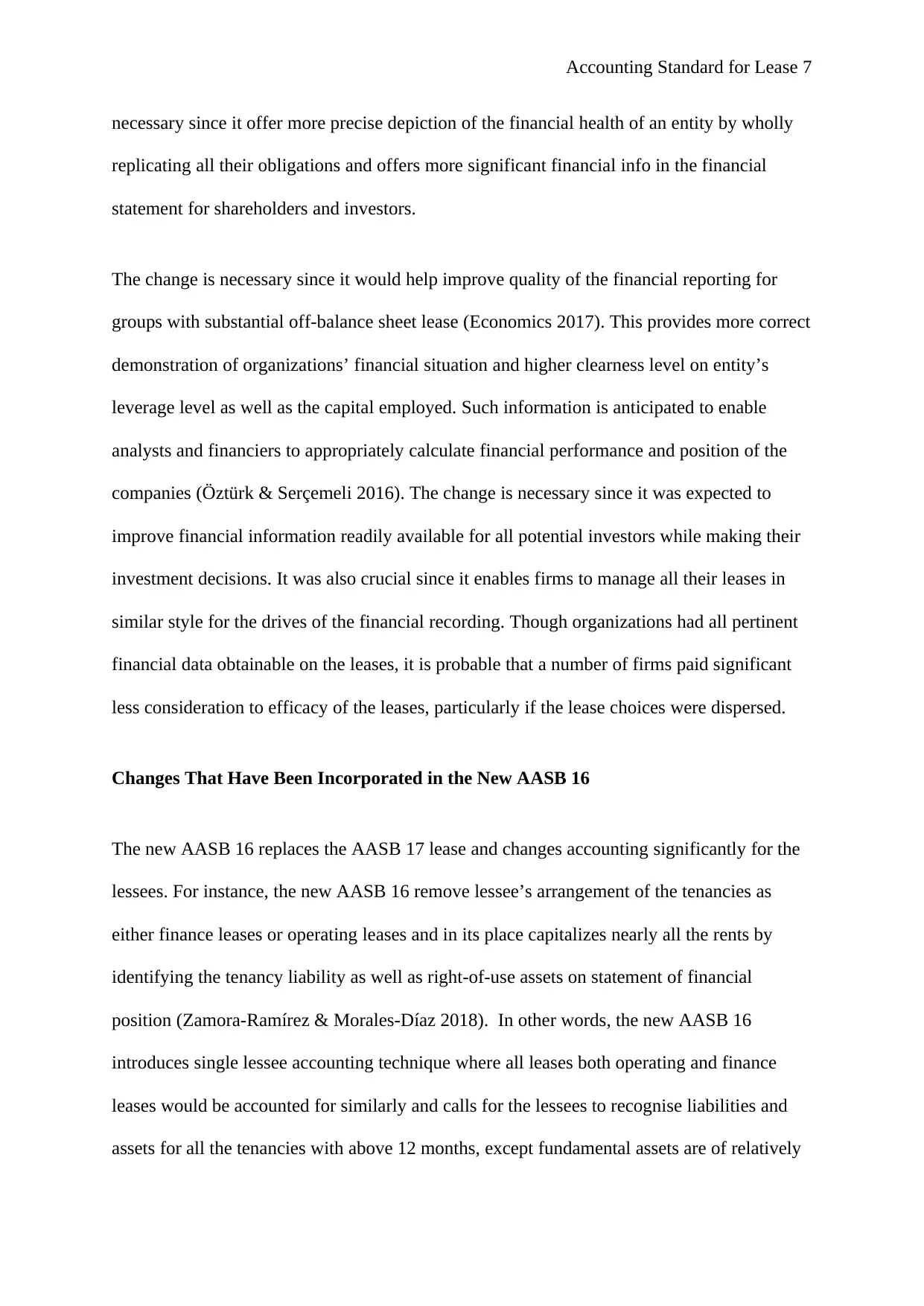
Accounting Standard for Lease 7
necessary since it offer more precise depiction of the financial health of an entity by wholly
replicating all their obligations and offers more significant financial info in the financial
statement for shareholders and investors.
The change is necessary since it would help improve quality of the financial reporting for
groups with substantial off-balance sheet lease (Economics 2017). This provides more correct
demonstration of organizations’ financial situation and higher clearness level on entity’s
leverage level as well as the capital employed. Such information is anticipated to enable
analysts and financiers to appropriately calculate financial performance and position of the
companies (Öztürk & Serçemeli 2016). The change is necessary since it was expected to
improve financial information readily available for all potential investors while making their
investment decisions. It was also crucial since it enables firms to manage all their leases in
similar style for the drives of the financial recording. Though organizations had all pertinent
financial data obtainable on the leases, it is probable that a number of firms paid significant
less consideration to efficacy of the leases, particularly if the lease choices were dispersed.
Changes That Have Been Incorporated in the New AASB 16
The new AASB 16 replaces the AASB 17 lease and changes accounting significantly for the
lessees. For instance, the new AASB 16 remove lessee’s arrangement of the tenancies as
either finance leases or operating leases and in its place capitalizes nearly all the rents by
identifying the tenancy liability as well as right-of-use assets on statement of financial
position (Zamora-Ramírez & Morales-Díaz 2018). In other words, the new AASB 16
introduces single lessee accounting technique where all leases both operating and finance
leases would be accounted for similarly and calls for the lessees to recognise liabilities and
assets for all the tenancies with above 12 months, except fundamental assets are of relatively
necessary since it offer more precise depiction of the financial health of an entity by wholly
replicating all their obligations and offers more significant financial info in the financial
statement for shareholders and investors.
The change is necessary since it would help improve quality of the financial reporting for
groups with substantial off-balance sheet lease (Economics 2017). This provides more correct
demonstration of organizations’ financial situation and higher clearness level on entity’s
leverage level as well as the capital employed. Such information is anticipated to enable
analysts and financiers to appropriately calculate financial performance and position of the
companies (Öztürk & Serçemeli 2016). The change is necessary since it was expected to
improve financial information readily available for all potential investors while making their
investment decisions. It was also crucial since it enables firms to manage all their leases in
similar style for the drives of the financial recording. Though organizations had all pertinent
financial data obtainable on the leases, it is probable that a number of firms paid significant
less consideration to efficacy of the leases, particularly if the lease choices were dispersed.
Changes That Have Been Incorporated in the New AASB 16
The new AASB 16 replaces the AASB 17 lease and changes accounting significantly for the
lessees. For instance, the new AASB 16 remove lessee’s arrangement of the tenancies as
either finance leases or operating leases and in its place capitalizes nearly all the rents by
identifying the tenancy liability as well as right-of-use assets on statement of financial
position (Zamora-Ramírez & Morales-Díaz 2018). In other words, the new AASB 16
introduces single lessee accounting technique where all leases both operating and finance
leases would be accounted for similarly and calls for the lessees to recognise liabilities and
assets for all the tenancies with above 12 months, except fundamental assets are of relatively
Paraphrase This Document
Need a fresh take? Get an instant paraphrase of this document with our AI Paraphraser
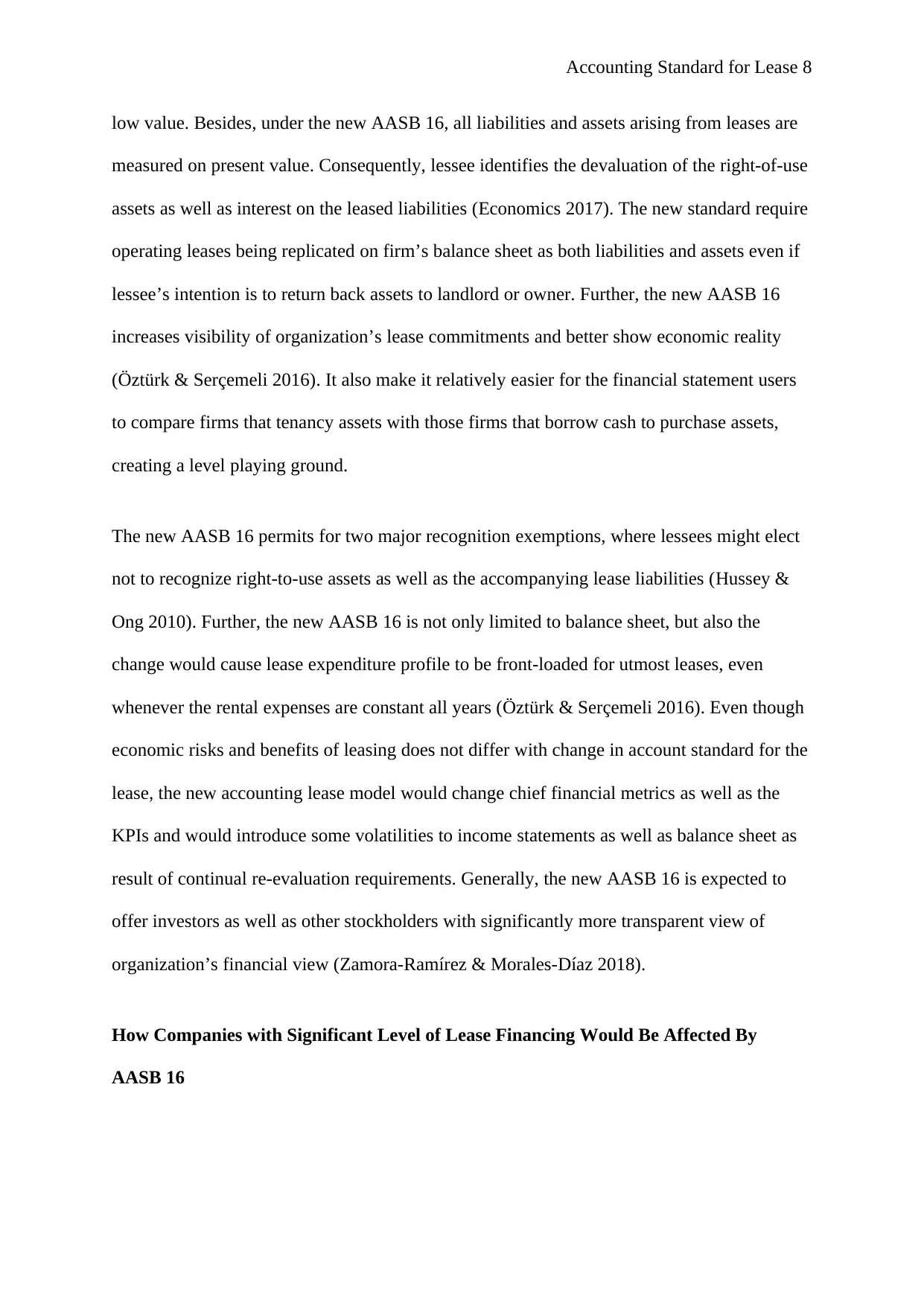
Accounting Standard for Lease 8
low value. Besides, under the new AASB 16, all liabilities and assets arising from leases are
measured on present value. Consequently, lessee identifies the devaluation of the right-of-use
assets as well as interest on the leased liabilities (Economics 2017). The new standard require
operating leases being replicated on firm’s balance sheet as both liabilities and assets even if
lessee’s intention is to return back assets to landlord or owner. Further, the new AASB 16
increases visibility of organization’s lease commitments and better show economic reality
(Öztürk & Serçemeli 2016). It also make it relatively easier for the financial statement users
to compare firms that tenancy assets with those firms that borrow cash to purchase assets,
creating a level playing ground.
The new AASB 16 permits for two major recognition exemptions, where lessees might elect
not to recognize right-to-use assets as well as the accompanying lease liabilities (Hussey &
Ong 2010). Further, the new AASB 16 is not only limited to balance sheet, but also the
change would cause lease expenditure profile to be front-loaded for utmost leases, even
whenever the rental expenses are constant all years (Öztürk & Serçemeli 2016). Even though
economic risks and benefits of leasing does not differ with change in account standard for the
lease, the new accounting lease model would change chief financial metrics as well as the
KPIs and would introduce some volatilities to income statements as well as balance sheet as
result of continual re-evaluation requirements. Generally, the new AASB 16 is expected to
offer investors as well as other stockholders with significantly more transparent view of
organization’s financial view (Zamora-Ramírez & Morales-Díaz 2018).
How Companies with Significant Level of Lease Financing Would Be Affected By
AASB 16
low value. Besides, under the new AASB 16, all liabilities and assets arising from leases are
measured on present value. Consequently, lessee identifies the devaluation of the right-of-use
assets as well as interest on the leased liabilities (Economics 2017). The new standard require
operating leases being replicated on firm’s balance sheet as both liabilities and assets even if
lessee’s intention is to return back assets to landlord or owner. Further, the new AASB 16
increases visibility of organization’s lease commitments and better show economic reality
(Öztürk & Serçemeli 2016). It also make it relatively easier for the financial statement users
to compare firms that tenancy assets with those firms that borrow cash to purchase assets,
creating a level playing ground.
The new AASB 16 permits for two major recognition exemptions, where lessees might elect
not to recognize right-to-use assets as well as the accompanying lease liabilities (Hussey &
Ong 2010). Further, the new AASB 16 is not only limited to balance sheet, but also the
change would cause lease expenditure profile to be front-loaded for utmost leases, even
whenever the rental expenses are constant all years (Öztürk & Serçemeli 2016). Even though
economic risks and benefits of leasing does not differ with change in account standard for the
lease, the new accounting lease model would change chief financial metrics as well as the
KPIs and would introduce some volatilities to income statements as well as balance sheet as
result of continual re-evaluation requirements. Generally, the new AASB 16 is expected to
offer investors as well as other stockholders with significantly more transparent view of
organization’s financial view (Zamora-Ramírez & Morales-Díaz 2018).
How Companies with Significant Level of Lease Financing Would Be Affected By
AASB 16
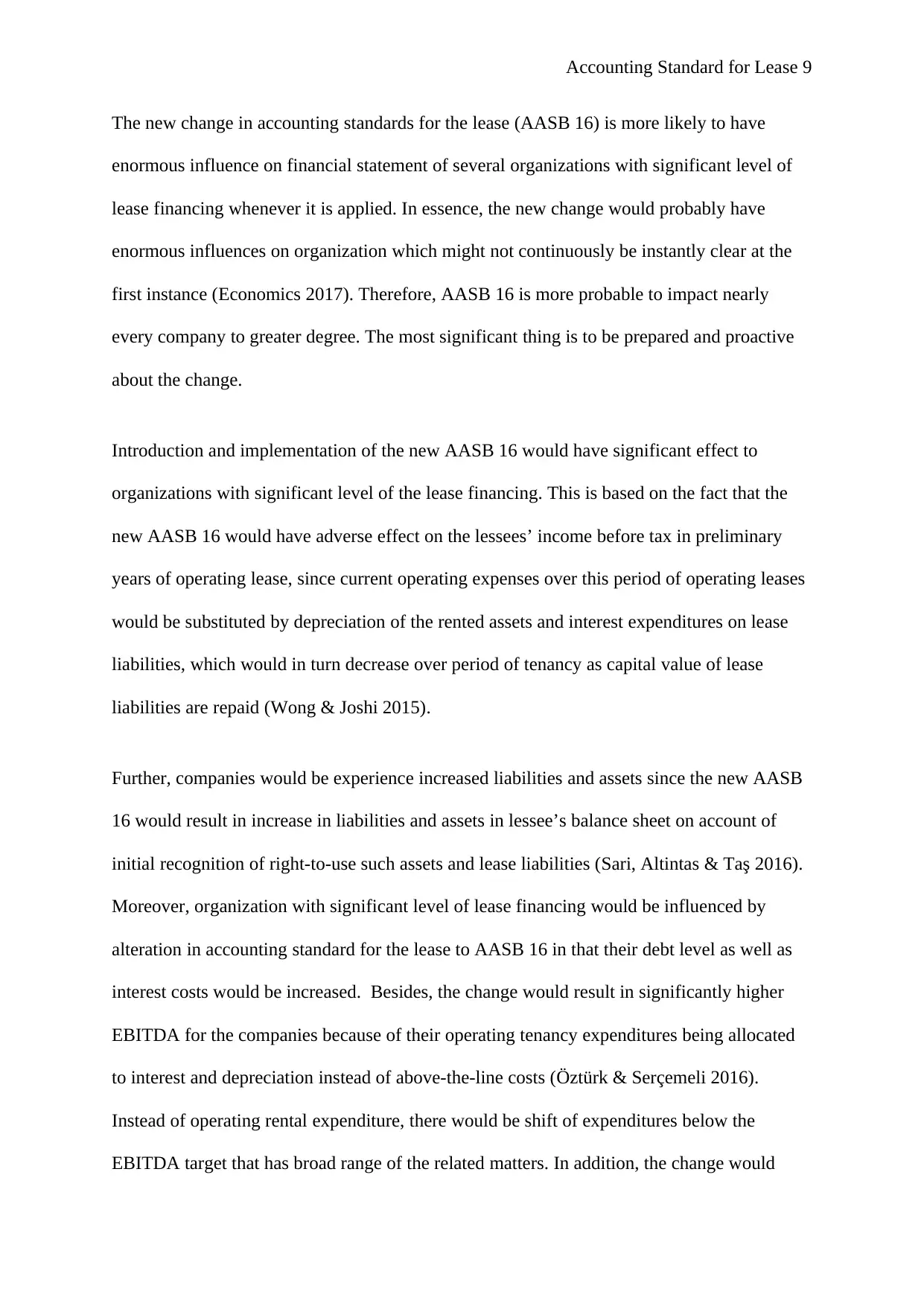
Accounting Standard for Lease 9
The new change in accounting standards for the lease (AASB 16) is more likely to have
enormous influence on financial statement of several organizations with significant level of
lease financing whenever it is applied. In essence, the new change would probably have
enormous influences on organization which might not continuously be instantly clear at the
first instance (Economics 2017). Therefore, AASB 16 is more probable to impact nearly
every company to greater degree. The most significant thing is to be prepared and proactive
about the change.
Introduction and implementation of the new AASB 16 would have significant effect to
organizations with significant level of the lease financing. This is based on the fact that the
new AASB 16 would have adverse effect on the lessees’ income before tax in preliminary
years of operating lease, since current operating expenses over this period of operating leases
would be substituted by depreciation of the rented assets and interest expenditures on lease
liabilities, which would in turn decrease over period of tenancy as capital value of lease
liabilities are repaid (Wong & Joshi 2015).
Further, companies would be experience increased liabilities and assets since the new AASB
16 would result in increase in liabilities and assets in lessee’s balance sheet on account of
initial recognition of right-to-use such assets and lease liabilities (Sari, Altintas & Taş 2016).
Moreover, organization with significant level of lease financing would be influenced by
alteration in accounting standard for the lease to AASB 16 in that their debt level as well as
interest costs would be increased. Besides, the change would result in significantly higher
EBITDA for the companies because of their operating tenancy expenditures being allocated
to interest and depreciation instead of above-the-line costs (Öztürk & Serçemeli 2016).
Instead of operating rental expenditure, there would be shift of expenditures below the
EBITDA target that has broad range of the related matters. In addition, the change would
The new change in accounting standards for the lease (AASB 16) is more likely to have
enormous influence on financial statement of several organizations with significant level of
lease financing whenever it is applied. In essence, the new change would probably have
enormous influences on organization which might not continuously be instantly clear at the
first instance (Economics 2017). Therefore, AASB 16 is more probable to impact nearly
every company to greater degree. The most significant thing is to be prepared and proactive
about the change.
Introduction and implementation of the new AASB 16 would have significant effect to
organizations with significant level of the lease financing. This is based on the fact that the
new AASB 16 would have adverse effect on the lessees’ income before tax in preliminary
years of operating lease, since current operating expenses over this period of operating leases
would be substituted by depreciation of the rented assets and interest expenditures on lease
liabilities, which would in turn decrease over period of tenancy as capital value of lease
liabilities are repaid (Wong & Joshi 2015).
Further, companies would be experience increased liabilities and assets since the new AASB
16 would result in increase in liabilities and assets in lessee’s balance sheet on account of
initial recognition of right-to-use such assets and lease liabilities (Sari, Altintas & Taş 2016).
Moreover, organization with significant level of lease financing would be influenced by
alteration in accounting standard for the lease to AASB 16 in that their debt level as well as
interest costs would be increased. Besides, the change would result in significantly higher
EBITDA for the companies because of their operating tenancy expenditures being allocated
to interest and depreciation instead of above-the-line costs (Öztürk & Serçemeli 2016).
Instead of operating rental expenditure, there would be shift of expenditures below the
EBITDA target that has broad range of the related matters. In addition, the change would
⊘ This is a preview!⊘
Do you want full access?
Subscribe today to unlock all pages.

Trusted by 1+ million students worldwide
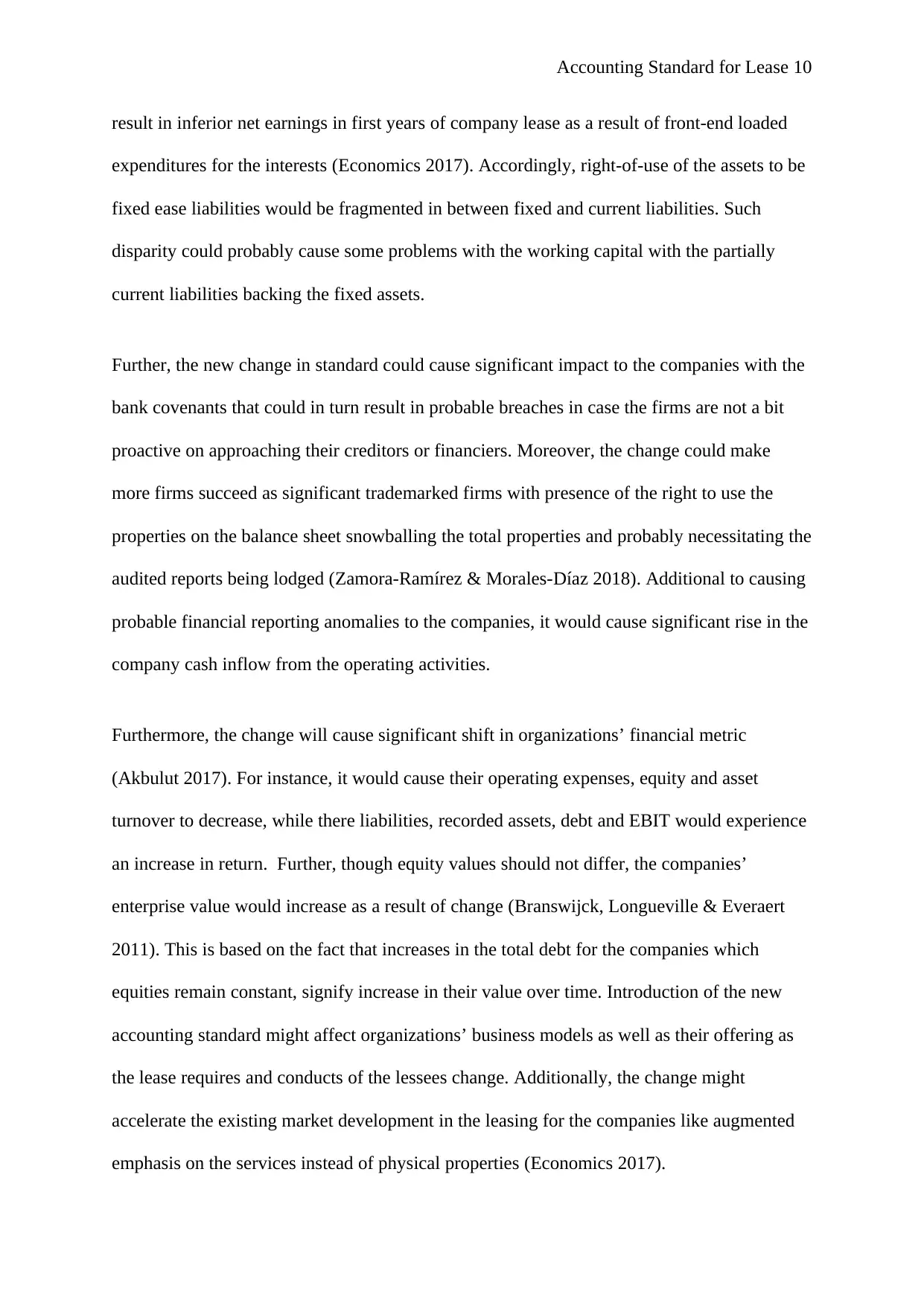
Accounting Standard for Lease 10
result in inferior net earnings in first years of company lease as a result of front-end loaded
expenditures for the interests (Economics 2017). Accordingly, right-of-use of the assets to be
fixed ease liabilities would be fragmented in between fixed and current liabilities. Such
disparity could probably cause some problems with the working capital with the partially
current liabilities backing the fixed assets.
Further, the new change in standard could cause significant impact to the companies with the
bank covenants that could in turn result in probable breaches in case the firms are not a bit
proactive on approaching their creditors or financiers. Moreover, the change could make
more firms succeed as significant trademarked firms with presence of the right to use the
properties on the balance sheet snowballing the total properties and probably necessitating the
audited reports being lodged (Zamora-Ramírez & Morales-Díaz 2018). Additional to causing
probable financial reporting anomalies to the companies, it would cause significant rise in the
company cash inflow from the operating activities.
Furthermore, the change will cause significant shift in organizations’ financial metric
(Akbulut 2017). For instance, it would cause their operating expenses, equity and asset
turnover to decrease, while there liabilities, recorded assets, debt and EBIT would experience
an increase in return. Further, though equity values should not differ, the companies’
enterprise value would increase as a result of change (Branswijck, Longueville & Everaert
2011). This is based on the fact that increases in the total debt for the companies which
equities remain constant, signify increase in their value over time. Introduction of the new
accounting standard might affect organizations’ business models as well as their offering as
the lease requires and conducts of the lessees change. Additionally, the change might
accelerate the existing market development in the leasing for the companies like augmented
emphasis on the services instead of physical properties (Economics 2017).
result in inferior net earnings in first years of company lease as a result of front-end loaded
expenditures for the interests (Economics 2017). Accordingly, right-of-use of the assets to be
fixed ease liabilities would be fragmented in between fixed and current liabilities. Such
disparity could probably cause some problems with the working capital with the partially
current liabilities backing the fixed assets.
Further, the new change in standard could cause significant impact to the companies with the
bank covenants that could in turn result in probable breaches in case the firms are not a bit
proactive on approaching their creditors or financiers. Moreover, the change could make
more firms succeed as significant trademarked firms with presence of the right to use the
properties on the balance sheet snowballing the total properties and probably necessitating the
audited reports being lodged (Zamora-Ramírez & Morales-Díaz 2018). Additional to causing
probable financial reporting anomalies to the companies, it would cause significant rise in the
company cash inflow from the operating activities.
Furthermore, the change will cause significant shift in organizations’ financial metric
(Akbulut 2017). For instance, it would cause their operating expenses, equity and asset
turnover to decrease, while there liabilities, recorded assets, debt and EBIT would experience
an increase in return. Further, though equity values should not differ, the companies’
enterprise value would increase as a result of change (Branswijck, Longueville & Everaert
2011). This is based on the fact that increases in the total debt for the companies which
equities remain constant, signify increase in their value over time. Introduction of the new
accounting standard might affect organizations’ business models as well as their offering as
the lease requires and conducts of the lessees change. Additionally, the change might
accelerate the existing market development in the leasing for the companies like augmented
emphasis on the services instead of physical properties (Economics 2017).
Paraphrase This Document
Need a fresh take? Get an instant paraphrase of this document with our AI Paraphraser
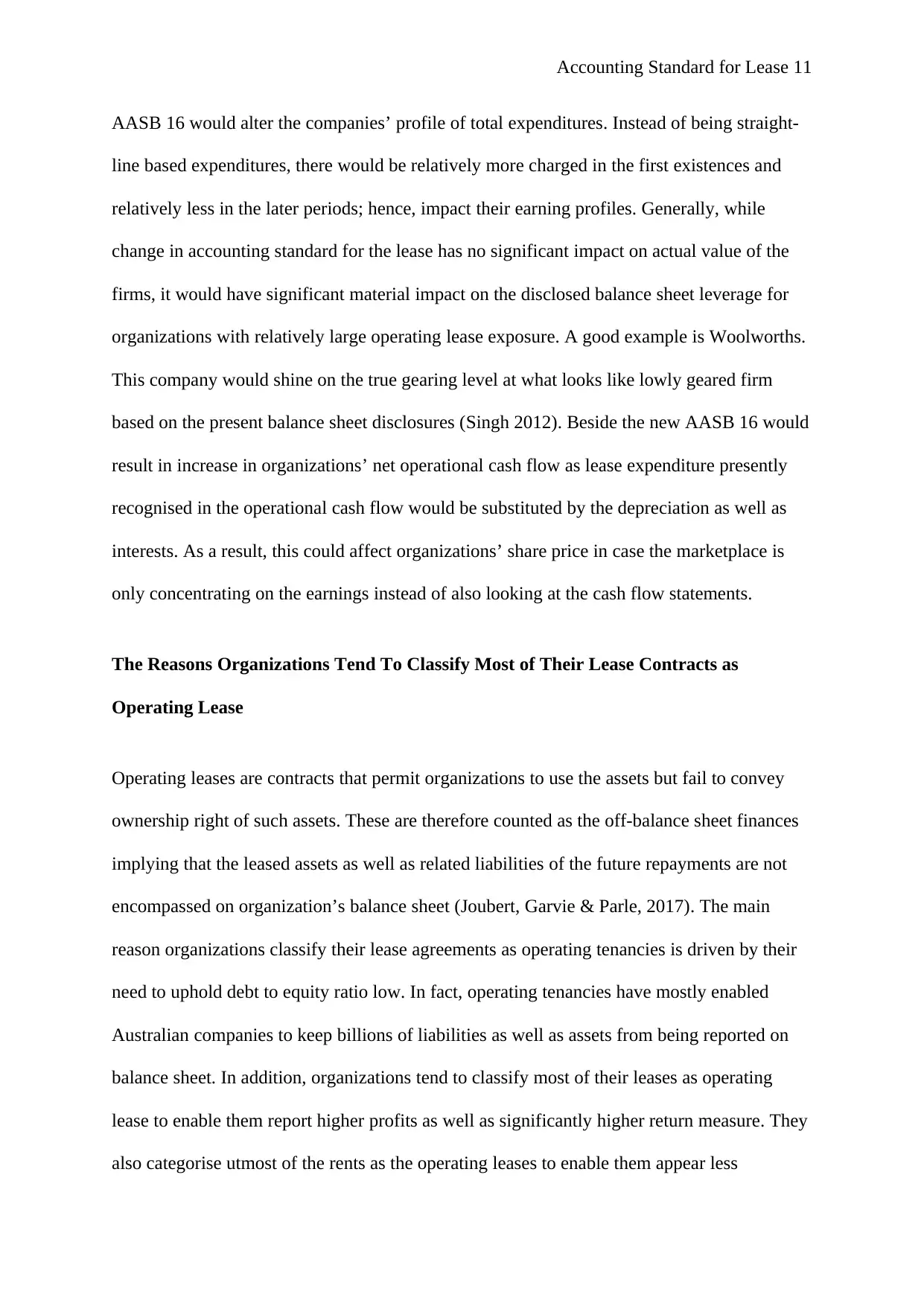
Accounting Standard for Lease 11
AASB 16 would alter the companies’ profile of total expenditures. Instead of being straight-
line based expenditures, there would be relatively more charged in the first existences and
relatively less in the later periods; hence, impact their earning profiles. Generally, while
change in accounting standard for the lease has no significant impact on actual value of the
firms, it would have significant material impact on the disclosed balance sheet leverage for
organizations with relatively large operating lease exposure. A good example is Woolworths.
This company would shine on the true gearing level at what looks like lowly geared firm
based on the present balance sheet disclosures (Singh 2012). Beside the new AASB 16 would
result in increase in organizations’ net operational cash flow as lease expenditure presently
recognised in the operational cash flow would be substituted by the depreciation as well as
interests. As a result, this could affect organizations’ share price in case the marketplace is
only concentrating on the earnings instead of also looking at the cash flow statements.
The Reasons Organizations Tend To Classify Most of Their Lease Contracts as
Operating Lease
Operating leases are contracts that permit organizations to use the assets but fail to convey
ownership right of such assets. These are therefore counted as the off-balance sheet finances
implying that the leased assets as well as related liabilities of the future repayments are not
encompassed on organization’s balance sheet (Joubert, Garvie & Parle, 2017). The main
reason organizations classify their lease agreements as operating tenancies is driven by their
need to uphold debt to equity ratio low. In fact, operating tenancies have mostly enabled
Australian companies to keep billions of liabilities as well as assets from being reported on
balance sheet. In addition, organizations tend to classify most of their leases as operating
lease to enable them report higher profits as well as significantly higher return measure. They
also categorise utmost of the rents as the operating leases to enable them appear less
AASB 16 would alter the companies’ profile of total expenditures. Instead of being straight-
line based expenditures, there would be relatively more charged in the first existences and
relatively less in the later periods; hence, impact their earning profiles. Generally, while
change in accounting standard for the lease has no significant impact on actual value of the
firms, it would have significant material impact on the disclosed balance sheet leverage for
organizations with relatively large operating lease exposure. A good example is Woolworths.
This company would shine on the true gearing level at what looks like lowly geared firm
based on the present balance sheet disclosures (Singh 2012). Beside the new AASB 16 would
result in increase in organizations’ net operational cash flow as lease expenditure presently
recognised in the operational cash flow would be substituted by the depreciation as well as
interests. As a result, this could affect organizations’ share price in case the marketplace is
only concentrating on the earnings instead of also looking at the cash flow statements.
The Reasons Organizations Tend To Classify Most of Their Lease Contracts as
Operating Lease
Operating leases are contracts that permit organizations to use the assets but fail to convey
ownership right of such assets. These are therefore counted as the off-balance sheet finances
implying that the leased assets as well as related liabilities of the future repayments are not
encompassed on organization’s balance sheet (Joubert, Garvie & Parle, 2017). The main
reason organizations classify their lease agreements as operating tenancies is driven by their
need to uphold debt to equity ratio low. In fact, operating tenancies have mostly enabled
Australian companies to keep billions of liabilities as well as assets from being reported on
balance sheet. In addition, organizations tend to classify most of their leases as operating
lease to enable them report higher profits as well as significantly higher return measure. They
also categorise utmost of the rents as the operating leases to enable them appear less
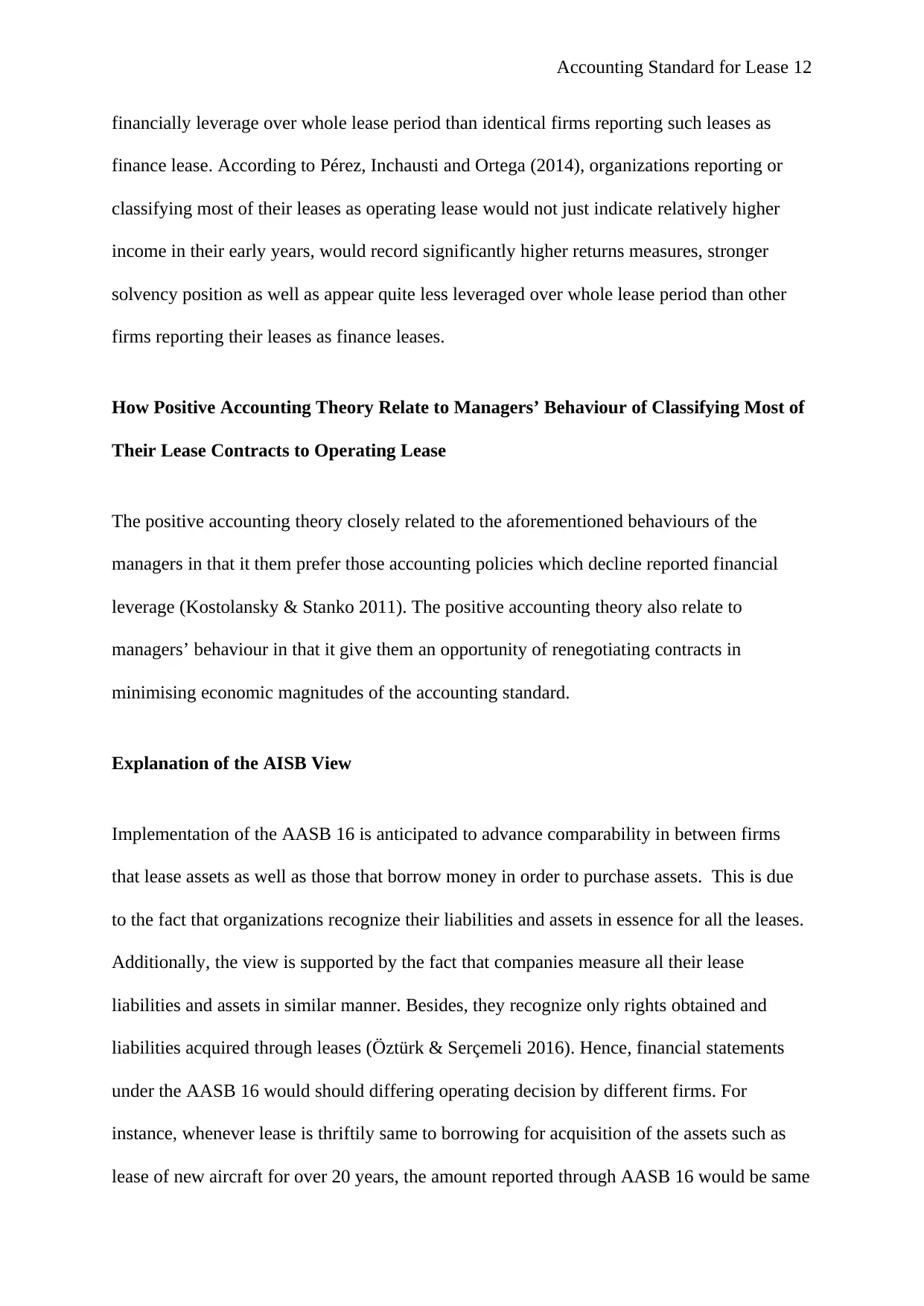
Accounting Standard for Lease 12
financially leverage over whole lease period than identical firms reporting such leases as
finance lease. According to Pérez, Inchausti and Ortega (2014), organizations reporting or
classifying most of their leases as operating lease would not just indicate relatively higher
income in their early years, would record significantly higher returns measures, stronger
solvency position as well as appear quite less leveraged over whole lease period than other
firms reporting their leases as finance leases.
How Positive Accounting Theory Relate to Managers’ Behaviour of Classifying Most of
Their Lease Contracts to Operating Lease
The positive accounting theory closely related to the aforementioned behaviours of the
managers in that it them prefer those accounting policies which decline reported financial
leverage (Kostolansky & Stanko 2011). The positive accounting theory also relate to
managers’ behaviour in that it give them an opportunity of renegotiating contracts in
minimising economic magnitudes of the accounting standard.
Explanation of the AISB View
Implementation of the AASB 16 is anticipated to advance comparability in between firms
that lease assets as well as those that borrow money in order to purchase assets. This is due
to the fact that organizations recognize their liabilities and assets in essence for all the leases.
Additionally, the view is supported by the fact that companies measure all their lease
liabilities and assets in similar manner. Besides, they recognize only rights obtained and
liabilities acquired through leases (Öztürk & Serçemeli 2016). Hence, financial statements
under the AASB 16 would should differing operating decision by different firms. For
instance, whenever lease is thriftily same to borrowing for acquisition of the assets such as
lease of new aircraft for over 20 years, the amount reported through AASB 16 would be same
financially leverage over whole lease period than identical firms reporting such leases as
finance lease. According to Pérez, Inchausti and Ortega (2014), organizations reporting or
classifying most of their leases as operating lease would not just indicate relatively higher
income in their early years, would record significantly higher returns measures, stronger
solvency position as well as appear quite less leveraged over whole lease period than other
firms reporting their leases as finance leases.
How Positive Accounting Theory Relate to Managers’ Behaviour of Classifying Most of
Their Lease Contracts to Operating Lease
The positive accounting theory closely related to the aforementioned behaviours of the
managers in that it them prefer those accounting policies which decline reported financial
leverage (Kostolansky & Stanko 2011). The positive accounting theory also relate to
managers’ behaviour in that it give them an opportunity of renegotiating contracts in
minimising economic magnitudes of the accounting standard.
Explanation of the AISB View
Implementation of the AASB 16 is anticipated to advance comparability in between firms
that lease assets as well as those that borrow money in order to purchase assets. This is due
to the fact that organizations recognize their liabilities and assets in essence for all the leases.
Additionally, the view is supported by the fact that companies measure all their lease
liabilities and assets in similar manner. Besides, they recognize only rights obtained and
liabilities acquired through leases (Öztürk & Serçemeli 2016). Hence, financial statements
under the AASB 16 would should differing operating decision by different firms. For
instance, whenever lease is thriftily same to borrowing for acquisition of the assets such as
lease of new aircraft for over 20 years, the amount reported through AASB 16 would be same
⊘ This is a preview!⊘
Do you want full access?
Subscribe today to unlock all pages.

Trusted by 1+ million students worldwide
1 out of 17
Related Documents
Your All-in-One AI-Powered Toolkit for Academic Success.
+13062052269
info@desklib.com
Available 24*7 on WhatsApp / Email
![[object Object]](/_next/static/media/star-bottom.7253800d.svg)
Unlock your academic potential
Copyright © 2020–2025 A2Z Services. All Rights Reserved. Developed and managed by ZUCOL.





